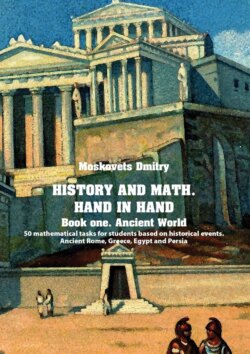Читать книгу History and math. Нand in hand. Book 1. Ancient World. 50 mathematical tasks for students based on historical events. Ancient Rome, Greece, Egypt and Persia - Dmitry Moskovets - Страница 5
Ancient Persia
ОглавлениеAncient Persia (or the «Achaemenid Empire) was a state that, at its height, stretched from Libya and Greece to India. According to some historians, the population of this ancient Empire reached 50 million: almost half the population of the entire planet at that time.
P.1.Grass tribute
The Persian Empire in 521 BC was divided into 20 satrapi8 and each of them paid tribute. However, there were areas that were not satrapies, but still had to pay tribute. For example, the Arabs in the territory of modern Jordan sent 1,000 talents9 of thyme creeper annually. Dried plants were brought to the Empire.
How many donkeys are needed daily to transport all the thyme for drying if there is 15% of moisture in dried thyme and 95% in newly harvested? One donkey transports a load of 5 talents once a day.
P.2. Gold and silver
Of course, a tribute in grass is an exotic type of tribute and, in fact, most of the tribute was paid in gold or silver. The greatest tribute in silver was paid by Babylonia and Assyria. The amount was 1,000 silver talents. Besides horses, grass and other «non-metal» tributes, Babylonia and Assyria paid 1/7 of the entire tribute in silver.
How many gold talents did India pay, if the value of silver was 3/4 of the tribute, and the gold was paid only by India. The ratio of silver to gold at that time was 1:10. (i.e., 1 gold coin was worth 10 silver coins, equal in weight). Determine the weight of all the gold tribute by India in kilograms. 1 Persian gold talent equals 1 silver in weight: 33.65 kg.
P.3. The population of the planet
Some historians suggest that at the height the Achaemenid Empire half the world population lived there. The most numerous at that time was the Indian nation, and 1/7 of the Indians was part of Achaemenid Empire. How many people lived outside India and Persia at that time, if the number of Hindus in the Achaemenid Empire was 10%? (Hint: read the beginning of the chapter).
P.4. Army size
The most important battles in the history of Ancient Persia are the Battle of Thermopylae, in September 480 BC, in which Leonidas10 and his 300 fearless Spartans went down in history for centuries, and the Battle of Gaugamela on October 1, 331 BC, after which the Achaemenid Empire ceased to exist, conquered by young Alexander the Great (see more in task D.4). In both cases, the Persians had huge armies: both armies added together constituted 0.9% of the total population of the Empire. How many Persian soldiers took part in the Battle of Gaugamela, if we know that there were 1/4 more of them than in the Battle of Thermopylae? The population of the Empire equaled 50 million.
P.5. The King`s «eyes» and «ears»
A whole army of spies worked for Cyras II the Great11. They were keeping an eye on everything that was going on in the Empire. Some even believe that the security servicemen lined up in a chain from the capital to the outskirts and shouted the latest news to the next in the chain.
It took thirty days for an army to march from the border of the Empire, but the king could know it was approaching in just one day because of his line of spies.
See whether this is possible if the army moves 8 hours a day, the king`s «ears» stand every 200m and the speed of sound 330 m/s. (for convenience sake, let it be 300 m/s). The speed is 5 km/h.
Let’s assume that it takes 10 second to convey the message from one spy to another.
P.6. Anniversary of Cyrus II.
Have you ever attended the king’s anniversary? No? But they are still held. Iran, for example, celebrated the 2,500 anniversary of the death of King Cyrus II in 1971. How long did Cyrus live, if he came to the throme in 559 BC, when he was 31 years old?
8
A satrapy is the territory in the Achaemenid Empire governed by a satrap.
9
A talent was a unit of weight and currency in the ancient times.
10
Leonidas I was a king of the Greek city-state of Sparta from 491 BC until 480 BC.
11
Cyrus II was the founder of the Achaemenid Empire, the first Persian empire.
